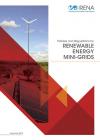

Policies and regulations for renewable energy mini-grids
Newsletter
Countries have adopted a range of approaches to the development of mini-grids, aiming to extend energy access to underserved areas or communities. Existing regulations, however, have often been inadequate to de-risk and finance such investments.
Off-grid renewables need to be woven into regional and national electrification planning processes as early as possible, particularly to make optimal use of decentralised solar and wind power. National rural electrification strategies, meanwhile, should incorporate specific policy and regulatory frameworks for renewable energy mini-grids.
Key factors to consider include legal and licensing provisions, tariff regulations, financial support, quality standards and eventual grid interconnection or arrival of main grid.
Complementary efforts are needed to build capacity across the value chain (from financing institutions to local communities), to identify cross-sector linkages, and to ensure sustainability. As mini-grid experience grows, policy review and design should continually incorporate the latest lessons.
By 2016, about 133 million people were served by off-grid renewables, with about 2.1 million people connected to solar photovoltaic (PV) mini-grids. Between 2008 and 2016, the number of people connected to mini-grids tripled to nearly 9 million across Asia, and grew six-fold to 1.3 million across Africa.




